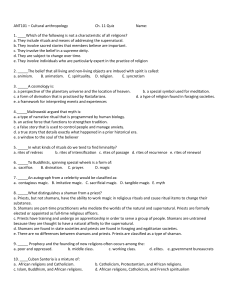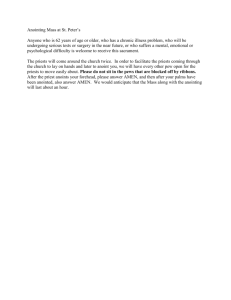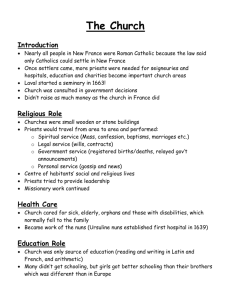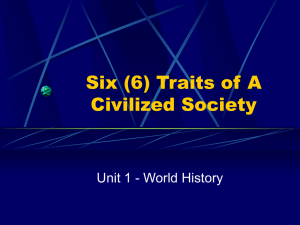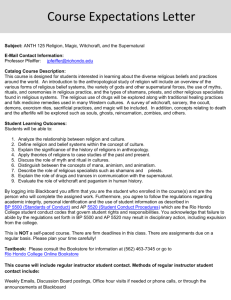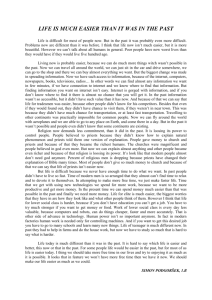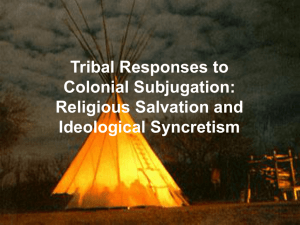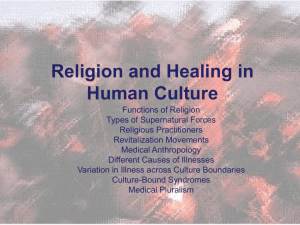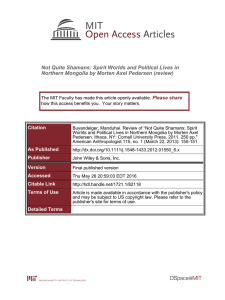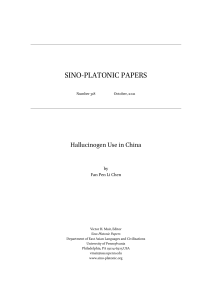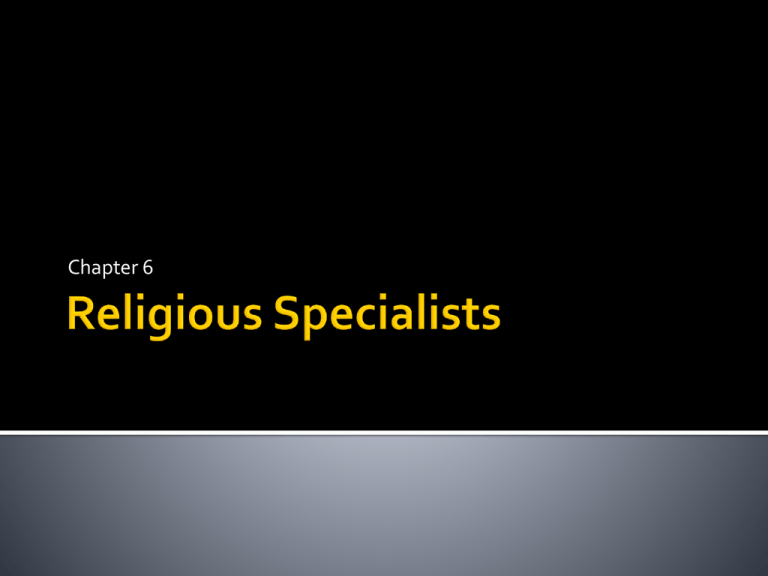
Chapter 6
Religious specialists have special abilities to
communicate with the spirit world
Can be full-time or part-time, focus on
individual or the community
Less complex, developing communities
Tend to be part-time (times of need)
More complex, technological communities
Tend to be full-time
We use Wallace’s 4 forms:
Individualistic
Shamanistic
Communal
Ecclesiastical
Individuals intentionally seek out spirits or
supernatural powers to protect them
Direct interaction
Vision quest: Great Plains Indians; spirit
comes in a vision; helps person on endeavors
No entire religion is individualistic
Shaman or medicine man is a person with
culturally defined special relationship to
supernatural powers
May heal sick
May have spirit helpers
May take hallucinogens
May become mediums
Many Hunter/Gatherer and horticultural
tribes
Acquire status in 3 ways
Period of special training as apprentice
Endure difficult deprivations
Experience unusual event
Ex: Jivaro of Ecuador
Sickness is caused by enemies
Bewitching shamans and curing shamans
Like shamanistic, these practices don’t have
full-time specialists
Have leaders who manipulate symbolic objects
Two types:
Ancestral
Rituals performed to worship kinship group’s
ancestors
Totemistic
Rituals focus on totem, or natural object. Clans are
associated with different totems
Totemism
Ancestor Worship
State-sponsored practices are ecclesiatical
practices
Highly organized
Held in large churches or temples
May have belief that ruler is “God-King”
Aztecs
▪ Human sacrifice
Egyptian Pharaoh
▪ pyramids
Henry VIII
Let’s talk more in depth about shamans and
priests
Usually there are said to be two main types of
religious specialists
However, these should be viewed as ends of a
continuum
Priests
Shamans
There are a lot of different definitions
Features include:
Direct communication with supernatural
Use spirit helpers
Use culturally appropriate paraphernalia
They are usually chosen by spirits
Can be called by dreams, trances, visions, or
abnormal behavior
Also after surviving an illness or having
certain illnesses
Book: Lia’s seizures
Can decide whether or not to pursue it
Contact and maintain relationship with spirits
Focus is on ability to contact (not on
knowledge)
Use ASC
Fight or appease spirits, heal and cure disease
Can be private or public
Use drumming, singing, chanting, dancing,
costumes
Axis Mundi: view that there are three zones
of the world
Supernatural, natural, and underworld
Shaman can travel through these
Also commonly linked to gender transitions
Western societies traditionally have twogender model
Deviance from this is “unnatural” and “sinful”
Gender crossing is the adoption of social roles
and behaviors normally appropriate for
opposite sex
In many cultures, gender crossing is
institutionalized, or expected by at least some
Gender crossing and sexual orientation are not
the same thing!
Berdache is term for males who take on
alternative gender
Are seen as religious healers
Anglo observers of crossed-genders
overemphasized sexual orientation
They were also judgmental and condemnatory
Bugis in Indonesia have:
Calalai: woman-man
Calabai: man-woman
Bissu: neither male nor female
Bissu is also part deity and part mortal
Role is the intermediary between supernatural
world and the people
Also bestow blessings on harvests, travels, and
protect from natural disasters
Read the “Berdache” article
Provide your own definition for a berdache
How is this tied to gender?
How do they end up a berdache?
These are full-time specialists in formal
religious institutions
Usually in complex, industrialized societies
Seen as representative of community
Supposed to be moral authority
How does society react when they act
inappropriately?
Perform prescribed rituals
Periodic (calendrical)
And in times of need
Rites of passage (weddings, funerals, baptism,
bris)
Also generalized
Reinforce community beliefs and behaviors
Focus is on knowledge and memorization
(not on contacting spirits)
High degree of specialization
Usually formally trained
Rite of Passage (ordained)
Priests can have strict hierarchy
Example:
Deacons assist priests
Priests lead churches
Bishops lead regions
In Roman Catholicism, can go to cardinals, pope…
How do priests and shamans differ?
PRIEST
Hierarchy of priesthood
Under formal government
(state)
Special training
High in social ladder; may
live better than others
Calendrical
People have spiritual
dependence on priest
SHAMAN
Work alone
No formal government
(band, tribe, chiefdom)
May not have special
training
Equal status as others
Crisis
No spiritual dependence
These fall in the spectrum and may overlap
with priests or shamans
Herbalists
Diviners
Use plants for curing
Many plants do have medicinal properties
Practices a set of techniques that obtains
unknowable information
Usually of the future or things dealing with
the supernatural
Often use ASC
Answer practical questions
Diviner gives diagnosis and healer gives cure
Are the mouthpiece for gods
They communicate the gods/gods’ words to
the people
Can also be shamans
Roles include:
Healing
Predicting future
Control nature
Judaism: Moses
Christianity: Jesus (may also be considered
deity)
Islam: Mohammed
Read Box 6.2 (African Healers Meet Western
Medicine)
Discuss in groups how this applies to the
book

